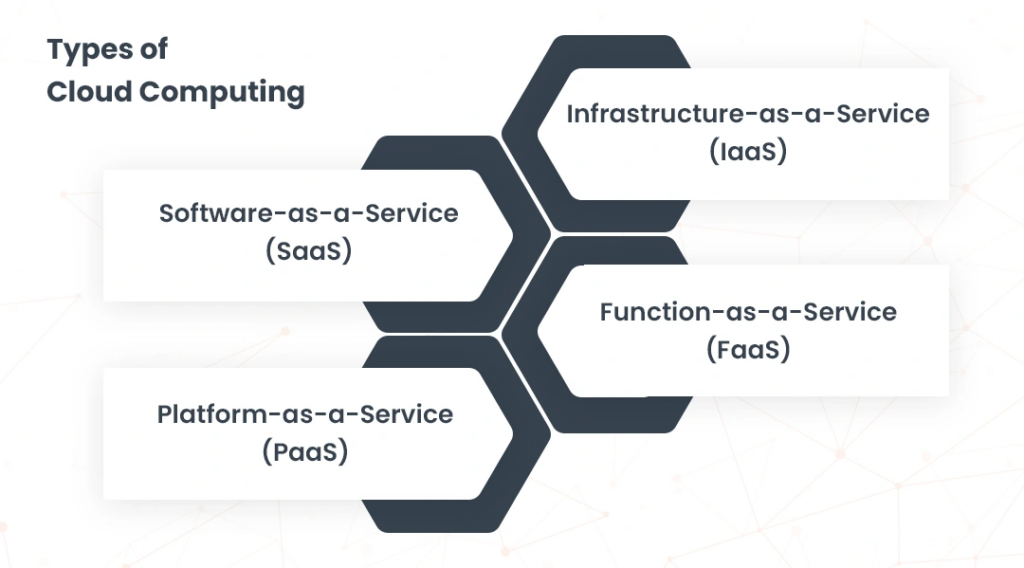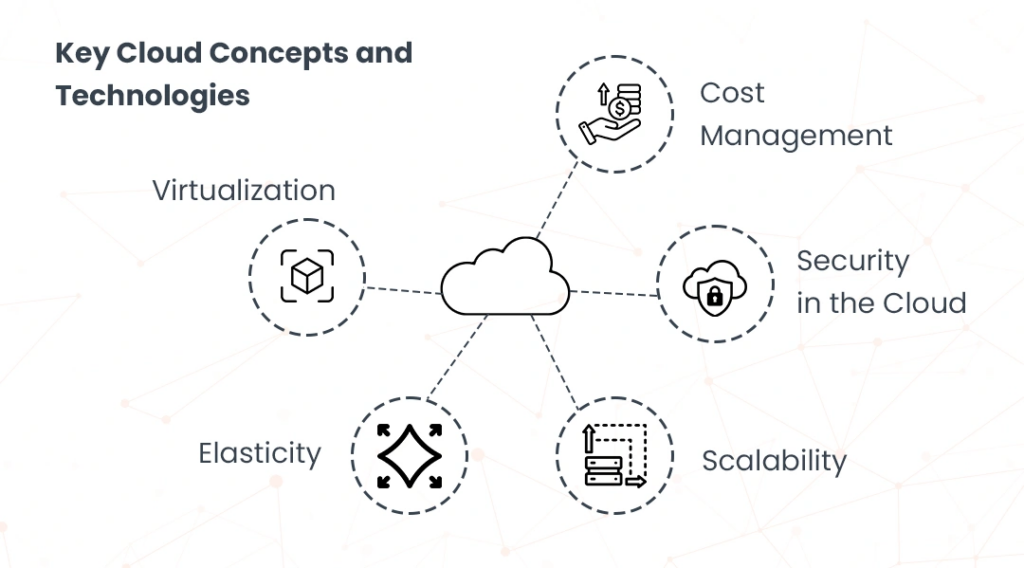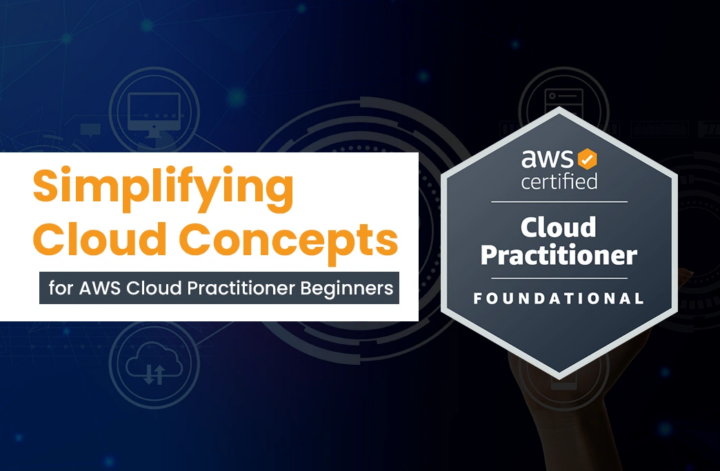This blog outlines the cloud computing concepts useful for an AWS Certified Cloud Practitioner. It breaks down cloud computing concepts as a beginner-friendly ally and you will also read about the AWS Console. This outline is a foundational roadmap for beginners to simplify their understanding of AWS concepts, enabling you to progress confidently in your cloud journey.
AWS Certified Cloud Practitioner
The AWS Certified Cloud Practitioner certification (CLF-C02) adds value to your cloud career by providing a foundational understanding of AWS and paves the way for your next cloud certification and the domain you choose to pursue. This certification validates a high-level understanding of AWS Cloud, its services, and terminology. The goal is to make AWS and cloud concepts approachable rather than overwhelming.
What is Cloud Computing?
The term “the cloud” describes servers that can be accessed online, along with the databases and software that operate on them. Data centers around the globe house cloud servers. Users and businesses can avoid managing physical servers and running software on their own computers by utilizing cloud computing.
Types of Cloud Computing

Software-as-a-Service (SaaS): SaaS apps are stored on the cloud servers and are used through the internet instead of being downloaded on a device. SaaS is like owning a house and leasing it out because while the owner chiefly uses it as their own residence, the landlord is responsible for maintenance.
Platform-as-a-Service (PaaS): Companies buy what they need to build their own applications, not hosted applications, as it may seem. PaaS has been compared with leasing all the tools and equipment necessary to construct a house instead of leasing the house.
Infrastructure-as-a-Service (IaaS): A business rents from a cloud provider the servers and storage it needs, including the software that runs on it. That cloud infrastructure is then used to create their apps. IaaS is similar to a business having a piece of land where they are able to build whatever they want—but they have to bring their own tools and blueprints.
Function-as-a-Service (FaaS): Also known as serverless computing, FaaS takes cloud apps even further by breaking them down into microservices that are only activated when needed.
What are the key cloud concepts and technologies?

Building every brick in place paves the way for the big picture. Understanding cloud terminology, for instance, and basic terms like “instance,” “bucket,” “region,” and “availability zone” are the aids to enhance cloud knowledge.
Virtualization
Virtualization enables the creation of virtualized versions of physical components, including operating systems, servers, storage devices, and networks. This software is used for procedures that normally call for a physical platform.
Elasticity
A system’s ability to adapt its computing resources to demand is known as cloud elasticity. It takes this action to fulfill workload requirements for a specified period of time. Among these resources are network bandwidth, RAM, and virtual CPU. You can release resources when they are no longer needed and access more when needed thanks to cloud elasticity.
Scalability
A cloud computing environment’s scalability is its capacity to readily grow or shrink its resources and services in response to demand. This adaptability makes it possible to smoothly handle changes in workload without sacrificing availability or performance.
As cloud services are scalable, users can modify their resource usage to suit their current requirements, maximizing operational efficiency and lowering costs.
In simple words, it is a simple analogy like a restaurant getting more tables depending on how many guests arrive, emphasizing how this saves money and improves performance.
Security in the Cloud
The technologies, controls, processes, and regulations that safeguard data, apps, and infrastructure hosted in the cloud are collectively referred to as cloud security. Strong cloud security is essential to protecting these environments as governments and corporations quickly embrace cloud computing to spur innovation and cooperation. We suggest you make use of the shared responsibility model.
Cost Management in AWS
Amazon Web Services offers a set of tools and features called AWS Cost Management to assist users in comprehending and managing their AWS usage and expenses. These tools provide detailed insights into your spending habits, allowing you to cut costs and better align your cloud investments with your business requirements.
Networking in AWS
Amazon Web Services provides a robust set of networking tools and services that let companies build high-performance, safe, and scalable cloud infrastructure. One such is the Amazon VPC.
AWS Core services and AWS Console
AWS EC2
Amazon EC2 is an essential solution for businesses and organizations in search of cost-efficient and elastic cloud computing services. Amazon EC2 is an AWS computing web service that lets you launch and operate virtual servers known as instances.
That makes Amazon EC2 quite versatile, as it is easily integrated with other AWS services. In your cases, users are not only able to host web servers but also to host applications, perform batch processing, data analysis, and many other things.
AWS S3
S3 (Amazon Simple Storage Service) offers secure and elastic storage service for any type of object. Some of the areas include data lakes, websites, mobile applications, business backup and restore processes, business enterprise applications, online archives, big data analysis, and internet of things devices. Customers are able to arrange for, schedule, and plan the patterns of data accessibility in order to meet legal and business requirements.
AWS RDS
AWS Amazon RDS is a web service that provides relational database services. Relational databases are those databases that hold data in tables having rows and columns. Amazon RDS provides a cost-optimized, large-scale, built-in relational database tool that is widely used in the industry. It offers users options that help to manage a relational database in the cloud more easily—from creation to use and expansion.
AWS Lambda
You can run code using AWS Lambda, a serverless computing solution, without having to manage or provision servers. Lambda runs your code on elastic, highly available infrastructure. It performs tasks related to the administration of compute resources, including server and operating system maintenance, automatic scaling, and capacity provisioning. Lambda is capable of executing code for practically any type of application service or backend.
AWS Identity and Access Management (IAM)
In AWS, IAM is one of the significant services used to define user access to AWS resources. The service is global and when a user is created, he or she can access AWS services from anywhere in the world. Each time you create your AWS account, the root account is configured for you automatically. Nonetheless, the advice is to use it more sparingly, preferably for the initial phase of an application only.
AWS Pricing Model
AWS has made available several options and models to help clients manage costs and capitalise on the best of the cloud computing services. To ensure that costs are well controlled, the Cloud resources are optimally utilized and you are only charged for what you use, it is important to understand how AWS costs work.
Read: The Future of Cloud Computing: Why Cloud Consulting Services Are Essential in 2025
Common misconceptions about cloud computing debunked
- Cloud is not a one-size-fits-all solution: Every business wants a wide variety of cloud computing options because they all have different needs and functions. There is a wide range of cloud platforms that can be customized to meet the demands and requirements of the business.
- Your data is not safe: Businesses may be hesitant to move to a public cloud because their data may not appear secure. However, in contrast to the general perception, cloud service providers have sophisticated firewall and anti-malware systems in place to protect against hackers. There is little opportunity for flaws because engineers who work on these platforms frequently find issues and update the system.
AWS CCP Certification Pathways
While AWS Certified cloud practitioner certification(CLF-C02) is the foundation for the next AWS certifications, choosing your stream accordingly will help in your career progression.
Whizlabs cloud resources are the perfect blend of comprehensive theory and practical experience. While you can get your basics strong with the video lectures that comprehensively cover key AWS concepts and services, making it ideal for both technical professionals and line-of-business employees – such as those in sales, product management, or project management – who want to develop cloud literacy and communicate more effectively with technical teams and clients, the hands-on labs and sandbox let you play around and apply your learnings practically.
A standout feature is the Sandbox environment, where you can experiment and build custom projects without worrying about service usage costs. The customised practice tests will validate your preparation and prepare you for the certification exam; the cheat sheet serves as a last-minute knowledge brush-up.
Importance of Hands-on learning in your Cloud Certification
In contrast to passively absorbing information from a webinar, hands-on training allows the learner to become proficient with the cloud. It gives users a chance to interact with the interface directly and gain a better understanding of how it functions or how it can support their business objectives. This method of system learning may even be more efficient and result in improved knowledge retention. Hands-on labs and Cloud sandboxes are the best solutions to get your hands-on practice.
Final thoughts
This blog simplifies the complex AWS services and demystifies cloud concepts for those starting their AWS Cloud Practitioner journey. Also encourages your further certification preparation to continue learning and exploring the cloud. Get a recap of cloud concepts for future growth in technology careers. In conclusion, the benefits of simplifying complex concepts to facilitate learning are exponential. Talk to our experts in case of queries!




